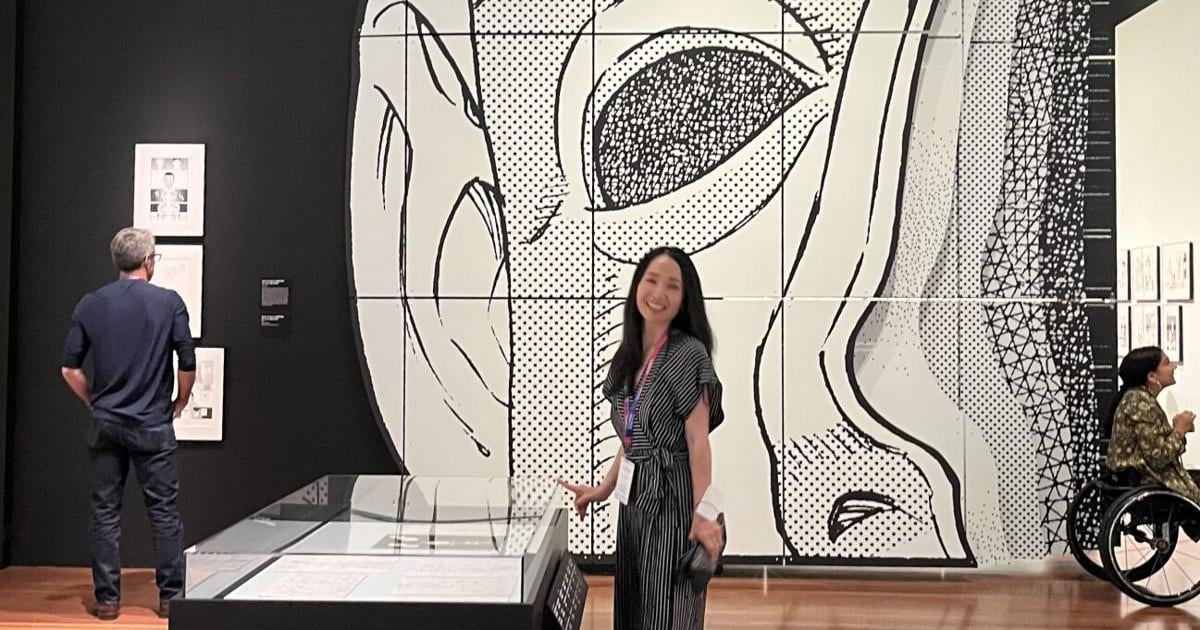A gleaming row of 80 Gashapon machines stretches along the entrance of the de Young Museum ready for visitors to spin. Each capsule toy dispenser, filled with miniature figures and manga icons, invites visitors to turn a knob and try their luck. What a playful curational gesture to capture the manga fandom and Japanese pop-culture.
Manga are Japanese graphic and comic novels, most of which conform to a style that originated in Japan in the late 19th century. Manga has experienced a rapid expansion from Japan to the world in the past two decades and gained significant global fandom. The worldwide manga market was valued at approximately $14 billion in 2023 and is projected to reach $50 billion within the next few years. In the U.S. market alone, manga makes up more than three quarters of overall comic and graphic book sales. This is the first major, large-scale exhibition of manga art in North America, highlighting manga’s history and its rise as a global cultural phenomenon. Dr. Nicole Coolidge Rousmaniere, an accomplished scholar of Japanese arts and culture, was commissioned to curate the first major manga exhibition in North America for the Fine Art Museums of San Francisco due to her leadership and experience in a major manga exhibition at the British Museum in 2019.
The Art of Manga exhibition at the de Young Museum traces the evolution of Japanese visual storytelling from its woodblock-print roots to today’s global graphic culture, featuring 10 extraordinary artists (Akatsuka Fujio, Chiba Tetsuya, Araki Hirohiko, Oda Eiichiro, Tagame Gengoroh, Takahashi Rumiko, Taniguchi Jirō, Yamashita Kazumi, Yamazaki Mari and Yoshinaga Fumi) with rarely displayed original drawings from 1970 to today.
Beshi, a manga frog character from the “Catch BESHI!!” Nintendo Switch game, guides museum visitors as the official exhibition mascot. The manga art form encompasses a broad range of genres including action, adventure, business, comedy, drama, history, mystery, romance, science fiction, fantasy, sexuality, etc., in distinctive styles of visual storytelling.
Among the highlights are works by painter and writer Yamazaki Mari, who attended the press preview in person and discussed her award-winning work “Plinivs,” the historical manga biography of Pliny the Elder, which reimagines the last days Pliny the Elder experienced before the eruption at Pompeii. Her drawing style echoes Renaissance paintings, particularly in how she renders facial expressions, character features, and the intricately detailed, historically-accurate settings of ancient Rome. She captures human emotions in dramatic moments with sometimes profound thoughts; at other times she delves into comic absurdity.
In comparison, Araki Hirohiko is known for his flashy coloring and fashion-forward, flamboyant style under the artistic influence of western art, Renaissance sculpture and fashion magazines. Highly stylized characters in fashion art textiles with gravity-defying bold poses in surreal battles and dramas are contrasted by highly detailed and realistic backgrounds, objects and scenery like Mt. Fuji, creating a unique balance between stylization and realism. A dedicated gallery showcases his characters with masculine human forms, big eyes, full lips and exaggerated gazes and postures.
On the museum’s upper floor, the accompanying display “How Manga is Made: ONE PIECE ONLY” demonstrates the creative process behind manga from hand drawn sketches to printing production dedicated to Oda Eiichiro’s “One Piece,” the bestselling manga series with more than 1,153 chapters and more than 510 million copies in circulation worldwide. A continuous wall displaying chapters 1 through 1,110 of “One Piece” creates an immersive experience for visitors. It has been so successful that it has official English-language YouTube channels and is available on streaming services like Netflix. My 13-year-old son was a huge fan of “One Piece” and regularly followed the Netflix series for more than a year.
From mythic spectacle to intimate comedy, this landmark exhibition sets the tone to celebrate both the artistry and accessibility of manga. Art evolves by crossing boundaries of medium, geography and narrative; the audience is sure to be inspired by their participation in the art of manga, and in the dialogue between print and idea.
Duanni Hurd is a Town Crier columnist covering arts, culture and lifestyle. Find her coverage of arts and performing arts on Instagram @duannihurd9.

